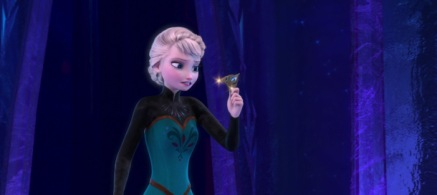Let it Go: The Disney song that did what no other Disney song has done before. Disney has created some memorable, beautiful, even life-changing music, but nothing – in my memory, anyway – compared to Let it Go. It was a Disney song that got overplayed and over-parodied so badly that it’s comparable to every Adele song ever. When a Disney song makes it onto bad talk shows and brain-numbing local news stations, you know it has truly grasped our collective consciousnesses. And it was horrible.
And yet, I admit it: I love this song, even still. I think it’s incredibly empowering. Today, I endeavour to find out why.
Let’s break this thing down, shall we? I disagreed with the incomparable Paul Bullock on this one, and when I mentioned it to erm she took his side, so I’m up against the big leagues here. Or the bigly, if you’re Trump. These two Disney gurus suggest that Let it Go is actually a mental breakdown of Elsa’s, and although both of them are happy to see it empowering women and girls and whoever else, they think that when you analyze it in context, the song isn’t, at its core, a power ballad. I disagree. I think it’s the ultimate Disney anthem. So let’s see what I can do here.
Let it Go as a Metaphor for Mental Illness
As many people smarter than myself have pointed out, Elsa’s story arc makes a fabulous parallel to mental illness. In that frame of mind, we can take a closer look at Let it Go specifically, and what’s actually going on in Elsa’s mind when it happens.
Whooooo I’m in over my head
We know that Elsa used her gloves as a rule – as long as she was wearing them, she was safe. In fact, Elsa has a variety of compulsions, which is aptly explained in the following:
“She’s utterly obsessed with this idea of perfection, and it’s not for no reason that her development mirrors that of an anxiety or OCD sufferer. She hits Anna with her powers, so stays away. This works, so her anxiety and compulsions tell her to keep doing it because it’s achieving what she wants it to achieve: keeping Anna alive. As with all anxiety and OCD, it grows in scale to the point where gloves and total isolation are a must that could result in catastrophe if denied for even a few seconds. Nothing less than perfection is acceptable.” – This
This passage made the song click for me, because it’s a situation I know all too well. Similar to Paul’s point about compulsions, anxiety and OCD, the gloves and avoidance ring true for me as someone who suffers from a specific phobia as well as GAD. People with anxiety create rules for themselves, which are supposed to make the world turn as it should. To better understand this, you need to understand that at the core of anxiety is one basic principle: There are things on this world outside of our control.
Taking, as an example, emetophobia: My specific fear is vomiting. This is something that, technically, I cannot prevent. But goddamn it, I’m going to try. I’m going to avoid public spaces, children, public transportation, airplanes (is that public transportation?), roller coasters, arcades (I once got sick after going to an arcade), unusual foods, fast food, meat, dairy, things that are unrefrigerated for longer than 15 seconds… and so on.
Elsa? She’s afraid of her ice powers. At this point, she can’t control them, either. Her fear is born from her lack of control. And so she creates rules. Gloves. Mantras. And isolation.
Second verse of the song, Elsa repeats her mantra:
“Don’t let them in
Don’t let them see
Be the good girl you always have to be
Conceal, don’t feel,
Don’t let them know
Well now they know”

This was repeated here to remind us of the mantra, just to drive the point home that we’re throwing out the rule book. These were the words that she repeated to herself her whole life. We know that mantras have power – positive mantras are used in cognitive behavioural therapy – but the point of this one came from a place of using arbitrary rules and compulsions to create a false sense of control, as a coping mechanism for anxiety. And now, Elsa lets go of her coping mechanisms. “Well now they know” is a freeing statement. It’s like saying, “Well, too late now.” Or, “What have we got to lose?” She is finally, for the first time, allowing herself some leeway on the rules that had given her the slightest sense of control.
The mantra and the gloves are two compulsions that Elsa has had since childhood. The third is isolation, which we know she’s not ready to ditch just yet. But when Elsa says “Let the storm rage on; the cold never bothered me anyway” – she’s letting go of those compulsions (and her cloak). And although she’s not totally there yet, she never re-adopts them. That kind of breakthrough could have taken months of therapy.
“It’s time to see what I can do
To test the limits and break through
No right, no wrong, no rules for me,
I’m free!”
Okay, okay, we know she’s not actually free. Her next song is yet another breakdown about how she’s ruining everything (but again, the compulsions never come back!) She may not be ready to be around Anna or rejoin society or anything, but she is doing something new: She’s using her powers. And considering that her powers were the entire source of her fear in the first place, this is definitely another breakthrough. Although we don’t get a lot of insight about Elsa’s life during the “Do you want to build a snowman” years, the few scenes we do see do not include her using her powers for fun – she’s always afraid of them, trying to control them, losing control of them, even when she’s alone.

In Let it Go, she takes the first big step to getting real control: She uses her powers. And she uses them well! She faced her fear.
Finally, one major factor that contributes to any type of mental illness is Locus of Control. It’s basically this:
Internal Locus of Control: I am in control of my own life. I am in control of how I handle whatever life throws at me.
External Locus of Control: My life is a series of random, or pre-determined, events outside of my control. I may not be able to handle these events.
Although being Internal as opposed to External doesn’t necessarily decide whether you’re mentally healthy or not, it’s one step towards overcoming anxiety, depression, addiction, OCD, and likely most emotional challenges you’ll face in life. Let’s read this into Elsa for a second.
She would have been External for much of her life. She knew she had to become Queen. She knew that she was a ticking ice-bomb set to blow up and kill everyone at any second. She felt as if she had no control. Additionally, she was terrified of not being able to handle the challenges before her – this is demonstrated in all dialogue with her parents during Snowman, as well as in her lines during Forever.
During Let it Go, something miraculous happens.

She takes her crown off of her head and throws it away.
Okay, maybe not the most rational or responsible decision. But in this moment, Elsa decided to take full control of her life, and how she was going to handle this particular challenge. This was a major step towards eventually finding inner peace. Again, I’m going to talk about myself for a second: This reminds me of when I decided to drop out of my first attempt at a Masters degree. I’ll skip the gritty details of how an accounting designation works, but basically, I dropped out of school because I couldn’t handle the pressure and the highly competitive environment. In hindsight, yes, I probably could have survived four more months of it and walked away with a Masters degree. And it would have been the easier choice – quitting something I’d set myself up to do was in direct conflict with everything I am. But I can’t say making that decision wasn’t liberating. I wouldn’t undo it for anything. When you’re a high-functioning anxiety type of person who holds herself to an inhuman standard of perfection, giving up every once in a while is a messy, difficult, even violent act of self-care. So when Elsa decides to screw Arendelle and live her own life, I have nothing but admiration for that choice. She built herself a see-through new house and decided to quit being Queen, throwing away what was probably a priceless relic of her kingdom but whatever Elsa it’s okay you’re just getting over your emotional difficulties in life. Speaking of which:
Let it Go as a Tale of Teenage Angst
Okay, I didn’t mean for that to sound dismissive. Teenage angst is legit. Coming of age is nothing but one seemingly-impossible challenge after another, with a side order of constant judgement and never being able to get anything right. I wouldn’t relive that part of my life for any amount of money.
I was in high school from 2006 to 2010, so at the very height of my own version of teen angst was another phenomenon: The emo movement.
Good times, right?
If you’re unfamiliar due to age or cultural differences, here’s a wikipedia article. It’s hilarious that this exists. Or you could just read My Immortal because that’s basically everything you will ever need to know about being 12 in 2004.
The question I want to ask here, in the context of the inexplicable emo movement of the 2000’s, is this: Since when does a song have to be healthy and positive in order to be empowering?
Exhibit A: One of my favourite songs, released in 2007.
Yes. I, a 16-year-old honours student who attended Catholic school and was obsessed with Harry Potter, listened to this song on repeat in 2007 because it was so deliciously melodramatic.
Music like this gives you permission to be imperfect. It gives you permission to cry for no reason and want to scream at people and make mistakes and want to give up. It’s okay to not be okay:
https://www.youtube.com/watch?v=qRFhNZNu_xw
Because these guys said so. And I’d be lying if I said I didn’t still absolutely love listening to this music. Mostly it’s the nostalgia – I love being transported back to the glory days of my teenage years just for a few minutes by cranking up Taking Back Sunday on the highway, or singing along to literally anything by Simple Plan circa-early 2000’s.
But wait. Didn’t I just say that I wouldn’t want to relive that stuff for anything? Why do I get such a kick out of listening to lyrics like,
the truth
is you could slit my throat
And with my one last gasping breath
I’d apologize for bleeding on your shirt
YIKES. That’s You’re So Last Summer by Taking Back Sunday, and I vividly remember a girl I knew having this as her MSN picture for a while. Yes, I am now citing MSN pictures. What is happening?
So why is my only fond memory of teenagedom really unnecessarily violent imagery in loud-yet-whiny rock music?
The one upside to being a teenager is that you are allowed to feel things. You feel them deeply. You run up to your room and slam the door and cry about something someone just said to you even though in a few weeks you’ll have forgotten what it was and moved onto the next injustice. You can’t get away with that stuff as an adult!
Feeling things, screwing up, getting emotional – it’s all just a part of growing up. Inside Out will tell you that. And even though it’s painful, it’s also completely, 100% worth it.
The bottom line? Violent lyrics, breakdowns, and super-loud singing can be empowering! For the first time in forever Elsa is allowing herself to be a screwup. In the context of high-functioning anxiety, to me, this is hella empowering. Nothing is more empowering than owning your complete undoing, and rocking an incredible dress while you do it.
Let it Go as a Source of Female Empowerment
As evidence, I present all the little girls who sang this song for like a year straight. It wasn’t annoying at all. Okay, it was annoying.
Only because I hate kids.
Anyway, no discussion of Let it Go (or indeed, Frozen) would be complete without doing a feminist reading. And as I said last time, it’s simply wrong to disregard something that girls obviously enjoy and respond to! (For the record, Paul and erm weren’t doing that. If they were I obviously wouldn’t hold them in high enough regard to respond in long-form.)
I think there’s more than enough evidence to read Let it Go as a positive commentary on sexuality. The queer reading suggests that you can see this as a coming out story. Observe:
I don’t care
what they’re going to say
let the storm rage on,
The cold never bothered me anyway
If you’re reading the storm as rampant anxiety, this kind of sucks. But if the storm is the social repercussions of being outed as LGBTQIA+, the song changes its tune a bit, doesn’t it?
The feminist reading doesn’t have to differ. Women are encouraged to stifle their sexuality because, one way or another, it’s wrong and shameful. Either you like the wrong people, you have the wrong body, or you’re asking for men to hurt you. There’s a complex set of guidelines in place which basically rule against any show of sexuality whatsoever from a woman. So when Elsa lets her hair down, it’s kind of an AW YEAH GO GIRL I DON’T SAY THESE THINGS moment for us:

So rather than female empowerment, this is more of a sexual empowerment. I don’t really want to have a discussion about whether or not that is appropriate for children because ***yawn*** and also what are you doing bringing your children to a Disney movie anyway I do not know or care about such things. I’ll just say this: If you’re uncomfortable with subtle themes of sexuality in a children’s movie, that is probably an example of the female-shaming that I was just referring to.
Also, early Disney features old men being positively obsessed with their Princelings getting it on and creating heirs and EVERYONE WAS COOL WITH THAT.
Anyway. Let it Go shows Elsa taking down her hair and putting on a sexy ice gown and she continues to be a protagonist even though she’s showing a bit of skin now. And she sings at the top of her voice while she’s at it. For female audience members, this is a huge moment. We never get to enjoy things like this in movies.

Because when we do, it’s always about a guy.
Elsa doesn’t have a guy. At this point, she has no love interest at all. She’s exploring her identity through changing her appearance, and making ice sculptures, and quitting her day job. She’s making a huge mess of things, yes. And she’s in a state of emotional turmoil. Yes.
But she never changes back into that coronation dress. She never ties her hair back up. And she never puts the gloves back on. This song is a metamorphosis, and an anthem for owning your true feelings and making reckless choices and freeing yourself from your self-inflicted cage.





Good breakdown and inspection of the song! I guess my opinions of it are somewhere in between Paul’s and yours.